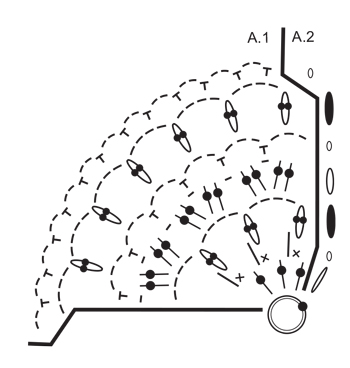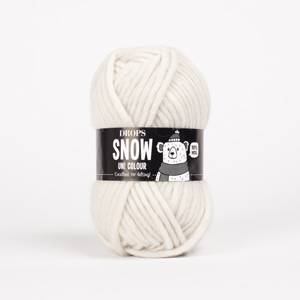Comments / Questions (9)
![]() Andrea wrote:
Andrea wrote:
Heihei! Jeg skal hekle noen av disse og har noen spørsmål: Hvor tykke blir disse etter toving? Er de tykke nok til å beskytte bordet fra varmen? Kan de varme pannene potensielt ødelegge de lyse fargene?
27.09.2024 - 14:42DROPS Design answered:
Hei Andrea. Kommer litt an på hvor hardt vaskemaskinen din tover, men vil tippe ca 1 - 1,2 cm. Skal beskytte bord fra varmen, men det kommer jo også an på hvor varm pannene er. mvh DROPS Design
07.10.2024 - 11:51
![]() Tuula wrote:
Tuula wrote:
Hi! I bought enough Snow yarn to make 4 potholders (Polar Circle by DROPS Design). I have never felted before and would like to know, can I put all 4 potholders in the washing machine at the same time? Also, my washing machine spins normally at 1400. Is that to "hard" of a spin? Thanks in advance for your answer.
15.02.2024 - 14:29DROPS Design answered:
Hi Tuula, Yes, all 4 potholders can be felted at the same time and 1400 is fine for the centrifuge. Happy crafting!
16.02.2024 - 07:07
![]() Beata wrote:
Beata wrote:
Hej! Kan man tova flera grytunderlägg på samma gång i maskinen? Tack på förhand. Vänlig hälsning, Beata
31.12.2021 - 01:07DROPS Design answered:
Hej Beata, vi skriver normalt at man tover separat i maskinen, men man kan jo altid prøve med et par stykker eller flere :)
05.01.2022 - 08:21
![]() Linda wrote:
Linda wrote:
Hello! Which Drops I can use instead of Drops Snow? Snow is not available here.
30.11.2020 - 07:49DROPS Design answered:
Dear Linda, DROPS Snow is the new name of DROPS Eskimo - your store might have still some Eskimo in stock or might be waiting for new shipment. Use the yarn converter to see alternatives, but remember you should also find a wool that could be felted - your DROPS store will help you choosing the best matching yarn, even per telephone or by e-mail. Happy crocheting!
30.11.2020 - 09:55
![]() Yvonne wrote:
Yvonne wrote:
Lätt att göra, lätt att tova, lätt att tycka om ❤️
09.12.2019 - 15:00
![]() Noah wrote:
Noah wrote:
Hej! Jag har precis påbörjat ett arbete i min syslöjd där jag faktiskt tänkt att virka detta fina grytunderlägg. Men jag har en fråga, vilken virkteknik använder man sig av när man stickar detta grytunderlägg? Tacksam för svar!
11.11.2019 - 12:49DROPS Design answered:
Hei Noah. Her bruker man forskjellige hekleteknikker. Du finner blant annet luftmasker, kjedemasker, fastmasker, halvstav, stav osv. Ta også en titt på videoen til gryteunderlaget, der ser du hvordan det hekles etter diagrammet. God Fornøyelse!
11.11.2019 - 15:28
![]() Kuyle wrote:
Kuyle wrote:
Bonjour , je souhaiterais faire ce modèle plus grand ; puis-je continuer A1 une fois ou 2 en plus ??? En vous remerciant , cordialement .
01.07.2019 - 12:22DROPS Design answered:
Bonjour Mme Kuyle, vous pouvez probablement agrandir ce modèle en répétant A.1, ajustez bien pour que vous ayez le bon nombre de motifs en largeur. Bon crochet!
01.07.2019 - 14:24
![]() Tina wrote:
Tina wrote:
Vielen herzlichen Dank :-)
04.04.2017 - 15:39
![]() Tina wrote:
Tina wrote:
Kann man mehre Untersetzer (unterschiedliche Farben) gleichzeitig filzen?
04.04.2017 - 15:02DROPS Design answered:
Liebe Tina, so können Sie machen, aber bitte die Farben beachten, < a href="https://www.garnstudio.com/yarn-care.php?cid=9">hier lesen Sie mehr. Viel Spaß beim filzen!
04.04.2017 - 15:14
Polar Circle |
|||||||||||||||||||||||||||||||
 |
 |
||||||||||||||||||||||||||||||
Crochet and felted trivet for Christmas in DROPS Snow.
DROPS Extra 0-1349 |
|||||||||||||||||||||||||||||||
|
PATTERN: See diagrams A.1 and A.2. Diagram A.2 shows how round beg and ends. COLOURS: Round 1: light grey ROUND 2: medium grey ROUND 3: off white Round 4: light grey ROUND 5: off white ROUND 6: medium grey Round 7: light grey COLOUR CHANGE: When changing colour work as follows: Before last pull through of last loop on hook, switch colour, pull the last loop on hook through with the new colour. Cut the yarn and fasten along the way. ---------------------------------------------------------- TRIVET: Crochet 4 ch on hook size 7 mm with light grey and form a ring with 1 sl st in first ch. Read COLOURS and COLOUR CHANGE! Crochet A.1 4 times in total on round - A.2 shows how round beg and end. REMEMBER THE CROCHET TENSION! FELTING: Place the trivet in the washing machine with a detergent without enzymes and optical bleach. Wash at 40 degrees with normal spin but no pre-wash. After wash shape the trivet to the right size while still wet and leave to dry flat. At subsequent wash, wash the trivet at regular wool programme. AFTER FELTING: If the piece is not felted enough and is too big: Wash the piece one more time in the washing machine while it is still wet add a terry towel that measures approx. 50 x 70 cm - NOTE: Do not use a short program. If the piece has been felted too much and is too small: While the piece is still wet stretch it to the correct measurements, if the piece is dry, make sure to soak it first. Remember: All subsequent washes are as a normal wool garment. |
|||||||||||||||||||||||||||||||
Diagram explanations |
|||||||||||||||||||||||||||||||
|
|||||||||||||||||||||||||||||||

|
|||||||||||||||||||||||||||||||
Have you finished this pattern?Tag your pictures with #dropspattern or submit them to the #dropsfan gallery. Do you need help with this pattern?You'll find 8 tutorial videos, a Comments/Questions area and more by visiting the pattern on garnstudio.com. © 1982-2025 DROPS Design A/S. We reserve all rights. This document, including all its sub-sections, has copyrights. Read more about what you can do with our patterns at the bottom of each pattern on our site. |
|||||||||||||||||||||||||||||||



















































Post a comment to pattern DROPS Extra 0-1349
We would love to hear what you have to say about this pattern!
If you want to leave a question, please make sure you select the correct category in the form below, to speed up the answering process. Required fields are marked *.